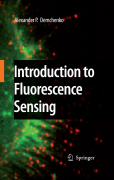
Fluorescence sensing is a rapidly developing field of research and technology. Its target is nearly the whole world of natural and synthetic compounds being detected in different media including living bodies. The application area range from control of industrial processes to environment monitoring and clinical diagnostics. Among different detection methods fluorescence techniques are distinguished by ultimate sensitivity, high temporal and spatial resolution andversatility that allows not only remote detection of different targets but their imaging within the living cells. The basic mechanism of sensing is the transmission of the signal produced by molecular interaction with the target to fluorescent molecules, nanoparticles and nanocomposites with the detection by devices based on modern electronics and optics. Covers the subject of fluorescence sensing comprehensively and systematically from different aspects (chemical sensors and biosensors; molecular sensors and nanosensors; designed and natural recognition units, up to whole living cells; sensor devices of various complexity) Based on the most important critically selected original journal papers published during last 3-4 years INDICE: Introduction. 1 Basic principles. 2 Theoretical aspects. 3 Fluorescence detection techniques. 4 Design and properties of fluorescence reporters.5 Recognition units. 6 Mechanisms of signal transduction. 7 Supramolecular structures and interfaces for sensing. 8 Non-conventional generation and transformation of response. 9 The sensing devices. 10 Focusing on targets. 11 Sensinginside the living cells and tissues. 12 Opening new horizons. Epilogue. Appendix: Glossary of terms used in fluorescence sensing. Index.
- ISBN: 978-1-4020-9002-8
- Editorial: Springer
- Encuadernacion: Cartoné
- Páginas: 590
- Fecha Publicación: 01/02/2009
- Nº Volúmenes: 1
- Idioma: Inglés
